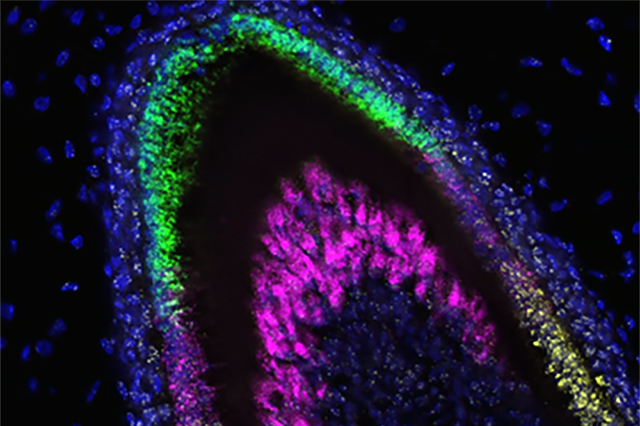A Multi-Disciplinary Team of Researchers Unlocks First Steps of Enamel Production
The team from the University of Washington in Seattle used stem-cell technologies to form organoids that secrete tooth enamel proteins.
Colors signify which genes are being expressed at each stage of development in this image of a developing incisor. | Image Credit: © UW Dental Organoid Research Team

In a paper published in the journal Developmental Cell, a multi-disciplinary team of researchers from the University of Washington in Seattle, recently announced the creation of organoids that secrete the proteins required to form tooth enamel.
“This is a critical first step to our long-term goal to develop stem cell-based treatments to repair damaged teeth and regenerate those that are lost,” Hai Zhang, professor of restorative dentistry at the UW School of Dentistry and one of the co-authors says in a press release.
Using stem cells as the basis of regrowing human organs has long been a goal of researchers, and teeth are a great place to start because they are a simpler structure than other organs, and the human body does not have a way to replace enamel it loses.
Enamel is the hardest substance in the human body, and it is created during the formation of teeth by specialized cells called ameloblasts that die off once tooth formation is complete.
“Many of the organs we would like to be able to replace, like human pancreas, kidney and brain, are large and complex. Regenerating them safely from stem cells will take time,” says research lead Hannele Ruohola-Baker, PhD, professor of biochemistry and associate director of the UW Medicine Institute for Stem Cell and Regenerative Medicine. “Teeth on the other hand are much smaller and less complex. They’re perhaps the low hanging fruit. It may take a while before we can regenerate them, but we can now see the steps we need to get there.”
Discovering those steps was a lengthy process. In order to convince stem cells to grow into ameloblasts in the laboratory, researchers first studied the genetic programming that produces them naturally. This was accomplished using single-cell combinatorial indexing RNA sequencing (sci-RNA-seq), which is designed to show the active genes during different stages of a cell's development by tracking the levels of messenger RNA through the different stages.
In this research, sci-RNA-seq was used to create a series of "snapshots" of gene activation at each stage of tooth development. This data was fed into Monocle, a sophisticated analysis software application that produced the likely trajectory of gene activities to develop stem cells into ameloblasts.
“The computer program predicts how you get from here to there, the roadmap, the blueprint needed to build ameloblasts,” Ruohola-
Baker says.
To then recreate the process in the lab, researchers exposed stem cells to chemical signals known to activate different genes. This was done to mimic the path predicted by the sci-RNA-seq data, but according to the press release it still required a lot of trial and error along the way.
One of the discoveries during the project was a new cell type named subodontoblast which researchers believe to be a progenitor of odontoblasts which also play a role in tooth formation.
The cells created from the stem cells could then be induced to form small, 3D, multicellular organoids which organized themselves into structures similar to those seen in developing teeth. These organoids also secreted ameloblastin, amelogenin, and enamelin, 3 essential proteins that form a matrix and mineralize to form enamel.
The next steps for this line of research are refining the production of these organoids and successfully creating enamel with durability similar to that found in natural dentition. Eventually, this line of research could lead to enamel dental fillings, and even potentially regrowing entire teeth.